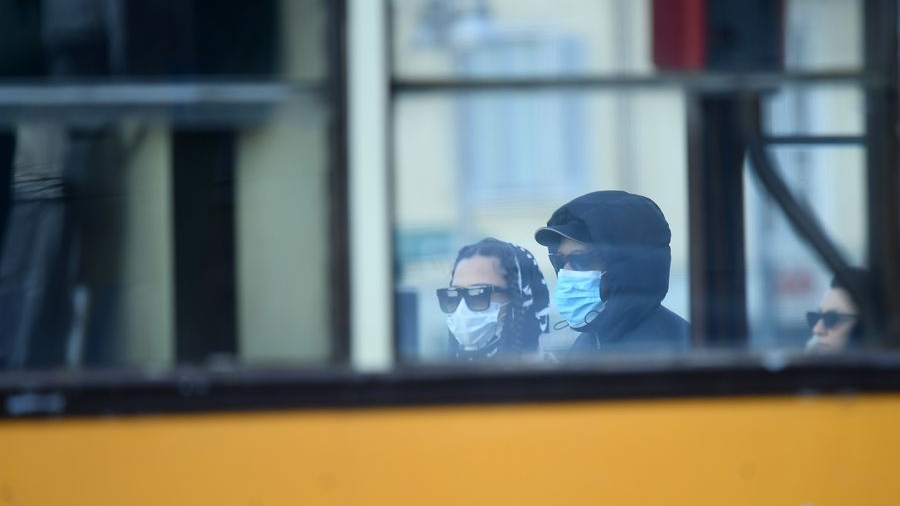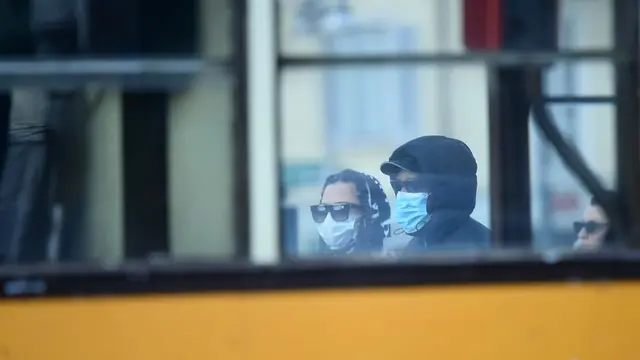
People wear face masks in Milan, Italy, February 26, 2020. /Xinhua
**Editor's note: **Federica Russo is a researcher at the consulting firm Wikistrat and a freelance writer whose articles have been published by Asia Times, The Diplomat, OBOReurope and other news platforms focused on business and geopolitics. The article reflects the author's views, and not necessarily those of CGTN.
Since the outbreak of the COVID-2019 in China, several countries across the globe have been challenged by its spread outside the national borders. Even people in the United States, the Middle East and Europe have been infected. Within the "Old Continent," Italy is seeing a high number of citizens who have positive coronavirus test results. Actually, with more than 600 cases, it has become the worst-hit country outside Asia.
The epicenter of the ongoing crisis in Italy is in the north, with Lombardy, Veneto, and Emilia Romagna representing the most affected regions, but infections have also been detected in Piemonte, Trentino Alto Adige, Lazio, Liguria, Tuscany, Sicily, Campania and Marche.
This has raised concerns about the epidemic spreading across the whole country. Data suggest that people with pre-existing health conditions are most likely to suffer from dangerous deterioration of their health, but the situation remains critical and authorities are promptly responding to the evolving situation in the affected regions.
Three actions have been taken. First, the cities which are the hotbed of the COVID-2019 are in quarantine; second, schools, stores and offices are being closed for 14 days in the surrounding areas; and third, the rest of the country is taking precautionary measures to ensure a consistent approach nationwide. In addition, in order to avoid speculative behaviors, the Italian Civil Protection with the support of the General Confederation of Italian Industry decided to purchase protective equipment and surgical masks, directly addressing the medical need of all the regions that could suffer due to supply shortages. Meanwhile, family doctors are receiving detailed instructions to identify symptomatic individuals who must receive special treatments.

A man walks past empty tables and seats in Milan, Italy, February 26, 2020. /Xinhua
Italy is also cooperating with neighboring countries. In particular, the Italian Minister of Health Roberto Speranza held a productive meeting with his counterparts from Germany, France, Austria, Switzerland, Croatia and Slovenia earlier this week. Health Ministers have agreed to share key information during regular conference calls, maintain open borders and jointly monitor the outbreak closely.
It is important to highlight that the COVID-19 is hitting Italy during a period characterized by political diatribe, slow economic growth and widespread social discontent.
The Northern region, which is most affected by the virus at the moment, is also the economic engine of the country. For example, Lombardy, Emilia-Romagna and Veneto collectively accounted for 40 percent of Italian economic output in 2017. The strict quarantine measures implemented in these regions could create downward pressure on Italy's national economic performance. In the face of the difficult circumstances, the government has rolled out a special ordinance on tax breaks to support those living in the virus-hit regions, but this may not be sufficient for businesses that are in need of greater financial assistance.
However, even if the government appears confident of dealing with the outbreak, some issues could affect the overall effectiveness of the action plan. First, political fissure and mistrust between regional and central government can weaken efforts to contain the virus. Second, political divisions within the central government is an issue. It remains to be seen if the shaky ruling coalition between the center-left Democratic party and the anti-establishment Five Star Movement can be united in leading Italy out of the public health crisis. Last but not least, it seems that the main sources of information have exaggerated the seriousness of the situation, leading to social fear and anxiety, panic buying and racism against Asians.
But now is not really the moment to open debates in order to find those who are guilty and who could be the saviors. This is the moment to cooperate in spite of divergent views and political differences. In this regard, Italy could surely learn from China, not least about the importance of a collective and coordinated action to tackle serious challenges.
(If you want to contribute and have specific expertise, please contact us at [email protected].)
 简体中文
简体中文

